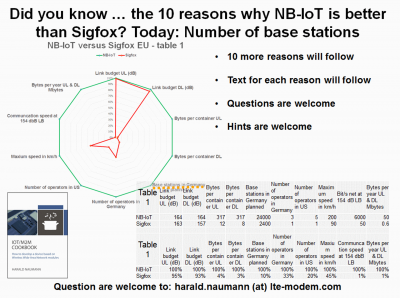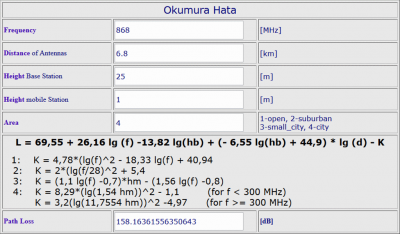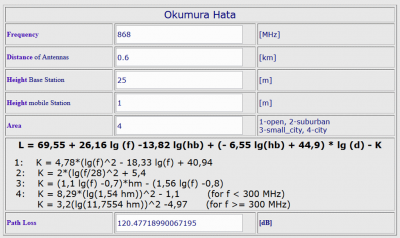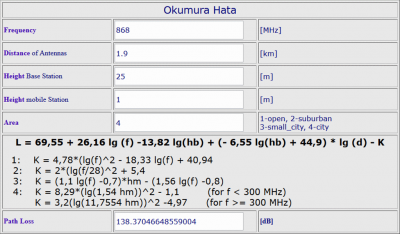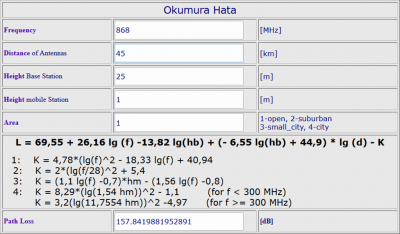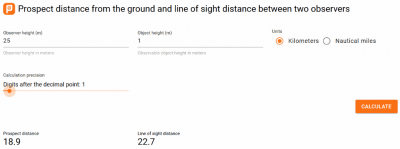In order to understand why more base stations automatically represent a better network, some explanations are necessary. Sigfox has planned 2400 gateways for Germany. These 2400 gateways are confronted with 24,000 LTE base stations from Vodafone and approximately the same amount from Deutsche Telekom. These 48,000 LTE base stations do not all need to be upgraded to NB-IoT to allow a good indoor network with NB-IoT in our German villages and towns.
With the same link budget, the same antenna height and transmission frequency, the range of two LPWAN systems of two different radio systems is the same regardless of marketing slogans. The range results from a simplified view (height of antenna base station + height of antenna mobile) x link budget. The link budget of Sigfox and NB-IoT is almost the same. Since the physics cannot be cheated, both LPWANs result in almost the same range.
Explanations and details about NB-IoT and Sigfox
NB-IoT offers a maximum link budget of 164 dB in upload and download. However, the 164 dB is not the goal for network development, because at 164 dB the energy consumption at NB-IoT is high. NB-IoT has so-called Coverage Enhancement Levels (CE) 0, 1 and 2. 164 dB is called CE 2. 154 dB corresponds to CE 1 and 148 dB is called CL 0. With CL 1 and therefore 154 dB link budget, the energy consumption with NB-IoT is lower than with Sigfox. With CL 0 and therefore a link budget of 148 dB or better, NB-IoT reduces the transmission power again, resulting in even lower energy consumption. With the same link budget and consequently the same range, NB-IoT requires less energy than Sigfox.
Example lone worker protection
Under extreme conditions, such as an emergency call device for lone workers, NB-IoT can send a message from the basement and receive an acknowledgement. With Sigfox, this is twice impossible in extreme cases. The asymmetrical link budget prevents an acknowledgement and Sigfox allows only four downloads per day. Four alarm messages per day are rather unlikely. However, such alarm devices for lone workers trigger an alarm as soon as the service technician lies on the floor. Nevertheless, lying on the floor can also occur during daily work. If this is the case, the service technician can reset the alarm. Furthermore, such alarm devices check periodically if a base station can be reached. If the base station cannot be reached, no message can be sent in the case of an alarm. However, the service technician will be informed automatically. A check of an available radio channel is also not provided by Sigfox. The service technician can therefore only hope that a network. Remember that a professional parachutist checks his parachute very carefully before the jump. Lone workers are automatically secured as effectively as possible. However, NB-IoT also wins with less critical applications such as an order button. The higher link budget helps to better penetrate the walls of buildings.
How to achive a resonable LPWAN indoor coverage
Considering that the number of antenna installations of an LPWAN with the same range and penetration is ten times higher, the wireless network is ten times better. To express it the other way round: when the base station is not set up densely enough, indoor network operation is not possible. For Germany, 2400 gateways equate to 146 km² per gateway. The area of a circle is calculated by radius x radius x pi. The 146 km² area results in a necessary radius of 6.8 km. Without buildings and without hills and mountains is only a theoretical area for Germany. Germany has many low mountain ranges and high mountains. On top of that, we live in stone houses and do not live in tents. Such a cement wall attenuates the radio signal by about 20 dB. Another 8 dB are expected for fading. 28 dB attenuation in total should be used for planning your own LPWAN to be on the safe side. If you want to reach the basement, the 28 dB attenuation is not sufficient in the calculation. For simplification, we stick to the 28 dB attenuation in the other thinking models in this article and following articles.
Free space attenuation, Egli attenuation and Hata attenuation online
With the link below you can calculate the free space attenuation, the Egli attenuation and the Hata attenuation yourself online. http://wwwpub.zih.tu-dresden.de/~guetter/candy/tools/candy-prop-outdoor.htm
In the next four examples, we will use the above online tool to calculate the range of the LPWAN.
LPWAN with 158 dB path loss in the city
In the above calculation we have set the required range to 6.8km, the antenna height of the gateway to 25m and the antenna height of the sensor to 1m. With the radio wave attenuation according to Hata, we maintain an attenuation of approx. 158 dB in the urban area. By random, this corresponds to the 6.8 km range with 2400 gateways for Germany. We call it random because the planning principles of Sigfox are not public.
LPWAN with 158 dB path loss plus 28 dB attenuation (wall and fading) in the city
In the calculation according to Hata City we used 28 dB attenuation for fading and the first wall. We kept the heights of the antennas and the transmission frequency. The 6.8 km are reduced to 600 meters!
LPWAN with 158 dB path loss plus 20 dB attenuation (wall without fading) in the city
In the calculation according to Hata City we used 20 dB attenuation for fading and the first wall. We kept the heights of the antennas and the transmission frequency. The 6.8 km are reduced to 1.9 km.
LPWAN in undeveloped region with 158 dB path loss
In the calculation we used 0 dB attenuation outside the city. The heights of the antennas and the transmission frequency have been retained. The 6.8 km increase to 45 km.
LPWAN with earth curvature and maximum line of sight
The line of sign for an observer on 25 meter and a second observer on 1 meter is 22.7 km. The Hata radio propergation model does not know the curvature of the earth. The 45 km range from the above calculation is limited by the sight.
After about 22.7 kilometers the maximum range is reached with 25 m high antenna for the base station and 1 m antenna height for the node. At 868 MHz the radio wave already bends a little and would even reach a bit further than the maximum visibility. The 45 km cannot be reached.
You can calculate online here https://planetcalc.com/1198/
Summary NB-IoT and Sigfox range
Since GSM offers only 144 dB link budget, NB-IoT and Sigfox have a higher range than GSM. If we compare the maximum range of NB-IoT and Sigfox and then uses NB-IoT with coverage level 1 (CE 1) and 154 dB link budget as a benchmark, the range of NB-IoT and Sigfox is almost the same. Since there is no disc world all LPWAN have to deal with the earth’s curvature. In addition to the curvature of the earth the topography and the buildings are added. If you take this into account when planning an LPWAN, a LPWAN with high base station density will always have better indoor coverage than a LPWAN with low base station density. 24,000 LTE base stations and therefore 24,000 possible NB-IoT base stations are ten times more than 2400 gateways. With 2400 antenna systems for LPWAN a reasonable indoor coverage in Germany based on the above calculation bases is practically impossible.
If you are planning your own LPWAN, then the above mentioned physical limits also apply to your wireless network. How to plan, test and build your own LPWAN is explained in detail in the new IoT M2M Cookbook with focus on LPWAN. Wireless network planning will be a chapter of the new book.
References:
- 24,000 LTE base stations Vodafone Germany: https://www.vodafone.de/newsroom/netz/rekord-beim-mobilfunkausbau-vodafone-nimmt-alle-3-stunden-eine-neue-lte-station-in-betrieb/
- 2400 planned Sigfox Gateway: Sigfox presentation 3rd – 14th November in Frankfurt am Main
- Free field damping and Hata Radio Propagation Online Tool: http://wwwpub.zih.tu-dresden.de/~guetter/candy/tools/candy-prop-outdoor.htm
- Line-of-Sight Online Tool: https://planetcalc.com/1198/
Does this article gain your interest? Do you have a wireless IoT idea? Do you plan an IoT device with embedded antennas? Do you have an IoT prototype and have a need for optimisation or price? If your answer to any of these qustions is “YES”. Then do not hesitate to drop an email to harald.naumann (at) lte-modem.com and to ask for an akorIoT radio adapter or some engineering services to make your IoT idea reality.
